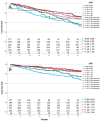The Cardiovascular-Mortality-Based Estimate for Normal Range of the Ankle-Brachial Index (ABI)
- PMID: 35621858
- PMCID: PMC9144270
- DOI: 10.3390/jcdd9050147
The Cardiovascular-Mortality-Based Estimate for Normal Range of the Ankle-Brachial Index (ABI)
Abstract
Background: The ankle−brachial index (ABI) is a first-line examination in cardiovascular risk evaluation. Since cut-off values for normal ABI vary, the aim of the present study was to identify the cardiovascular-mortality-based estimate for the normal range of the ABI. After determining the reference range for the ABI, the corresponding toe−brachial index (TBI) and toe pressure for normal ABI were analyzed. Methods: All consecutive non-invasive pressure measurements in the vascular laboratory of a large university hospital 2011−2013 inclusive were collected and combined with patient characteristics and official dates and causes of death. Patients with an ABI range of 0.8−1.4 on both lower limbs were included in this study. Results: From 2751 patients, 868 had bilateral ABI values within the inclusion. Both ABI category ranges 0.80−0.89 and 0.90−0.99 had poorer survival compared to ABI categories 1.00−1.29 (p < 0.05). The 1-, 3-, and 5-year cardiovascular-death-free survival for respective ABI categories 0.80−0.99 vs. 1.00−1.29 were 90% vs. 96%, 84% vs. 92%, and 60% vs. 87%. The 1-, 3-, and 5-year overall survival for ABI categories 0.80−0.99 vs. 1.00−1.29 were 85% vs. 92%, 75% vs. 83%, and 42% vs. 74%. Conclusions: Borderline ABI (0.90−0.99) associates with higher overall and cardiovascular mortality compared to ABI values 1.00−1.29.
Keywords: ABI; TBI; cardiovascular; mortality; survival.
Conflict of interest statement
The authors declare no conflict of interest.
Figures
Similar articles
-
Ankle-brachial index, toe-brachial index, and cardiovascular mortality in persons with and without diabetes mellitus.J Vasc Surg. 2014 Aug;60(2):390-5. doi: 10.1016/j.jvs.2014.02.008. Epub 2014 Mar 21. J Vasc Surg. 2014. PMID: 24657294 Free PMC article.
-
Additional prognostic value of toe-brachial index beyond ankle-brachial index in hemodialysis patients.BMC Nephrol. 2020 Aug 20;21(1):353. doi: 10.1186/s12882-020-01991-7. BMC Nephrol. 2020. PMID: 32819299 Free PMC article.
-
Toe Pressure and Toe Brachial Index are Predictive of Cardiovascular Mortality, Overall Mortality, and Amputation Free Survival in Patients with Peripheral Artery Disease.Eur J Vasc Endovasc Surg. 2017 May;53(5):696-703. doi: 10.1016/j.ejvs.2017.02.012. Epub 2017 Mar 11. Eur J Vasc Endovasc Surg. 2017. PMID: 28292565
-
Abnormal ankle-brachial index and risk of cardiovascular or all-cause mortality in patients with chronic kidney disease: a meta-analysis.J Nephrol. 2017 Aug;30(4):493-501. doi: 10.1007/s40620-017-0376-z. Epub 2017 Feb 15. J Nephrol. 2017. PMID: 28197971 Review.
-
The toe-brachial index in the diagnosis of peripheral arterial disease.J Vasc Surg. 2013 Jul;58(1):231-8. doi: 10.1016/j.jvs.2013.03.044. Epub 2013 May 18. J Vasc Surg. 2013. PMID: 23688630 Review.
Cited by
-
Therapeutic effects of transverse tibial bone transport in lower limb thromboangiitis obliterans.Am J Transl Res. 2025 Jun 15;17(6):4331-4340. doi: 10.62347/HAAJ5979. eCollection 2025. Am J Transl Res. 2025. PMID: 40672584 Free PMC article.
-
Atherosclerotic Cardiovascular Disease: Risk Assessment, Prevention and Treatment Strategies.J Cardiovasc Dev Dis. 2022 Dec 14;9(12):460. doi: 10.3390/jcdd9120460. J Cardiovasc Dev Dis. 2022. PMID: 36547456 Free PMC article.
-
Peripheral Arterial Disease in the Context of Acute Coronary Syndrome: A Comprehensive Analysis of Its Influence on Ejection Fraction Deterioration and the Onset of Acute Heart Failure.J Pers Med. 2024 Feb 26;14(3):251. doi: 10.3390/jpm14030251. J Pers Med. 2024. PMID: 38540993 Free PMC article.
References
-
- Roth G.A., Mensah G.A., Johnson C.O., Addolorato G., Ammirati E., Baddour L.M., Barengo N.C., Beaton A.Z., Benjamin E.J., Benziger C.P., et al. Global Burden of Cardiovascular Diseases and Risk Factors, 1990–2019: Update from the GBD 2019 Study. J. Am. Coll. Cardiol. 2020;76:2982–3021. doi: 10.1016/j.jacc.2020.11.010. - DOI - PMC - PubMed
-
- Aboyans V., Ricco J.B., Bartelink M.E.L., Bjorck M., Brodmann M., Cohnert T. Editor’s Choice-2017 ESC Guidelines on the Diagnosis and Treatment of Peripheral Arterial Diseases, in collaboration with the European Society for Vascular Surgery (ESVS) Eur. J. Vasc. Endovasc. Surg. 2018;55:305–368. doi: 10.1016/j.ejvs.2017.07.018. - DOI - PubMed
-
- Aboyans V., Criqui M.H., Abraham P., Allison M.A., Creager M.A., Diehm C., Fowkes F.G.R., Hiatt W.R., Jönsson B., Lacroix P., et al. Measurement and interpretation of the ankle-brachial index: A scientific statement from the American Heart Association. Circulation. 2012;126:2890–2909. doi: 10.1161/CIR.0b013e318276fbcb. - DOI - PubMed
-
- Gerhard-Herman M.D., Gornik H.L., Barrett C., Barshes N.R., Corriere M.A., Drachman D.E., Fleisher L.A., Fowkes F.G.R., Hamburg N.M., Kinlay S., et al. 2016 AHA/ACC Guideline on the Management of Patients with Lower Extremity Peripheral Artery Disease: A Report of the American College of Cardiology/American Heart Association Task Force on Clinical Practice Guidelines. Circulation. 2017;135:e726–e779. - PMC - PubMed
Grants and funding
LinkOut - more resources
Full Text Sources



